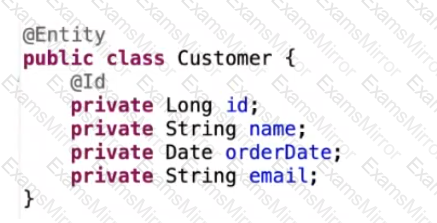Cyber Monday Special Limited Time 70% Discount Offer - Ends in 0d 00h 00m 00s - Coupon code = getmirror
Pass the VMware VCP-AM Develop 2022 2V0-72.22 Questions and answers with ExamsMirror
Exam 2V0-72.22 Premium Access
View all detail and faqs for the 2V0-72.22 exam
581 Students Passed
84% Average Score
90% Same Questions
Which two statements are true regarding Spring Security? (Choose two.)
Which three types of objects can be returned form a JdbcTemplate query? (Choose three.)
Refer to the exhibit.

Which two methods will be implemented at runtime if declared in a Spring Data JPA Repository? (Choose two.)
Which statements is true?
Spring puts each bean instance in a scope. What is the default scope? (Choose the best answer.)
Refer to the exhibit.

The above code shows a conditional @Bean method for the creation of a JdbcTemplate bean. Which two statements correctly describe the code behavior? (Choose two.)
Refer to the exhibit.

Which option is a valid way to retrieve the account id? (Choose the best answer.)
Which two statements are correct regarding Spring Boot auto-configuration? (Choose two.)
What are the two reasons Spring be used to build a Java application? (Choose two.)
Which is the correct approach to register for a bean destruction callback?
TOP CODES
Top selling exam codes in the certification world, popular, in demand and updated to help you pass on the first try.
